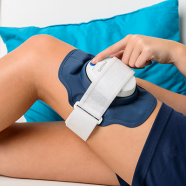Wearable Blue LED Light Therapy To Treat Psoriasis Vulgaris
Philips has announced the release of a wearable device that uses blue LED light to manage mild to moderate cases of psoriasis vulgaris. The device, which will be available through distributors this month in Germany, Netherlands and the U.K., is called Philips BlueControl and will offer an effective form of treatment for the skin condition without requiring medication.
Psoriasis is a skin condition that effects 125 million people across the planet. Of those suffering from the condition, 80% have the most common form, psoriasis vulgaris. Also known as plaque psoriasis, the condition causes plaques on the skin in the form of red raised skin and flakey “scales” that arise when the skin cells die. Symptoms of the condition include itching, pain and cracking. Needless to say, the physical and psychological effects can be debilitating for those patients suffering from this disease.
While the precise causes of psoriasis are unknown, it’s generally accepted that the condition arises following damage to the immune system, enzymes and other materials, which leads to uncontrollable growth of keratinocytes (immature skin cells that produce keratin, a tough protein found in nails, hair and skin) that triggers the skin flakes and inflammation as the body works to rid itself of the growth.
Existing treatments to reduce the symptoms of the condition include topical applications, prescription drugs and UV phototheraphy—a treatment which taxes patients and medical services by requiring frequent visits to doctors’ offices.
Looking for a better way to treat this incurable condition, researchers have found simple LED blue light treatment slows rapid cell division and can also reduce inflammation, which are the root causes of psoriasis vulgarsis.
Conducting clinical trials in Germany, Philips worked with researchers at the University Hospital of Aachen to investigate the safety and efficacy of the Philips BlueControl device to manage and calm symptoms of psoriasis vulgaris. The results showed a 50% reduction in symptoms as measured by the Local Psoriasis Area Severity Index (PASI), which checks for thickness, redness and scaling. Furthermore, no negative side effects were recorded in the study.
The battery-operated device has been developed to easily integrate into a patient’s daily routine and will reduce the need for physician visits. To use the device, patients strap it on their affected arms, legs, elbows and knees. The 40 non-UV blue LED lights used are different from LEDs used in other conventional applications because the lights feature “high intensities and tailored adjustments such as pulsed LED light,” according to Philips.
This isn’t the first use of blue LED light for medical applications. Earlier this year researchers at King’s College in London were able to restore muscular function in the formerly paralyzed legs of mice using stem cell neurons treated with blue LED light.
As LED technology advances and the researchers continue to broaden our understanding light therapies, we’re sure this won’t be the last time LEDs are used to improve people’s lives.
Any Questions?
Do you have any more questions about LED lights? We’d love to discuss LED strip light possibilities with you whenever you’re ready.
Contact:
Phone: 1-844-FLEXFIRE (1-844-353-9347)











